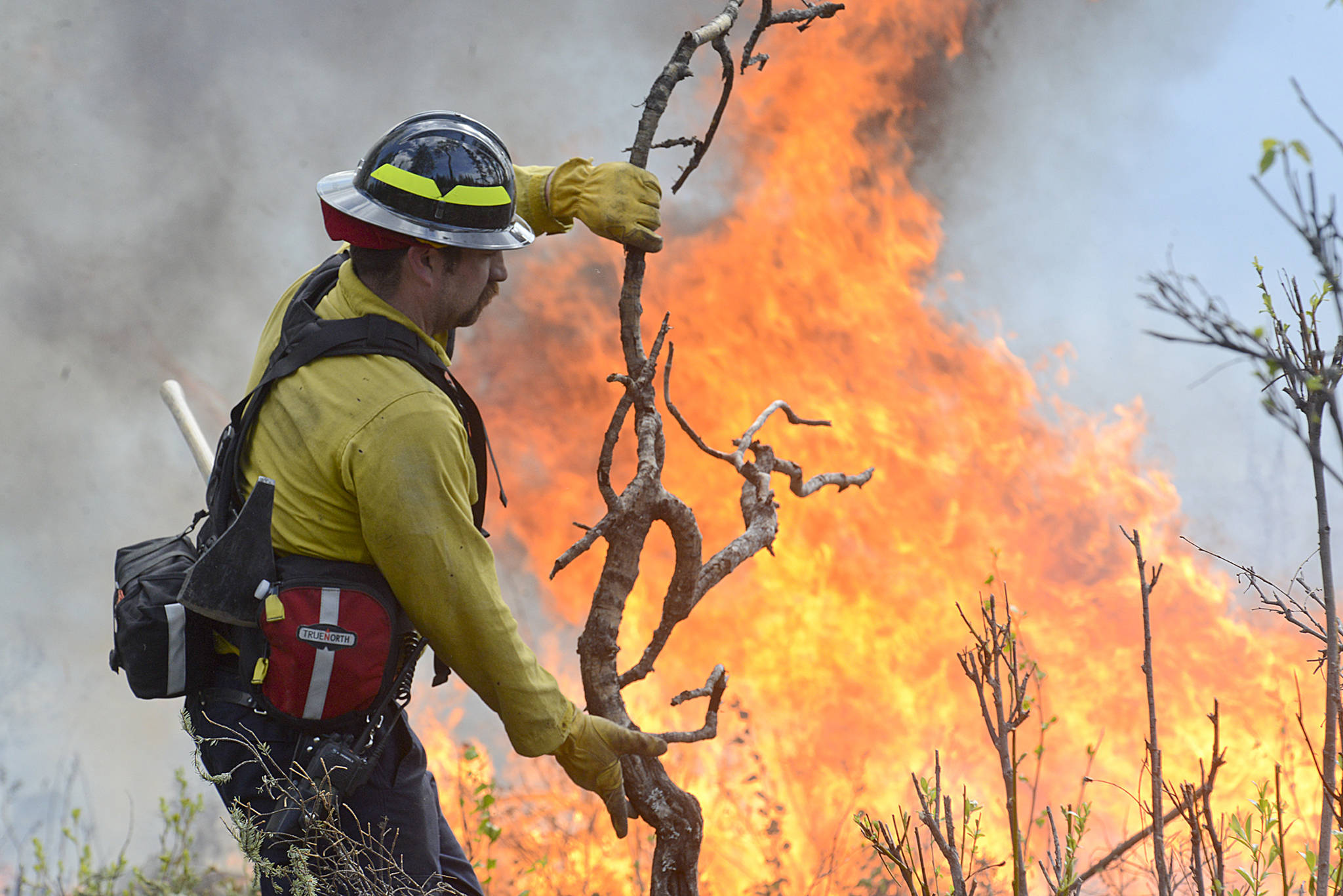Editor’s note: This story has been updated to include the U.S. Fish and Wildlife Service in the list of entities collaborating on a fule break being built in the Sterling area, as well as the fact that the Yukon Fire Crew has done hand work on the fuel break along with the Division of Forestry.
Alaska’s fire season won’t come in as hot and heavy as it did last year, but there is plenty of time for conditions to change, according to state forestry staff.
Alaska is forecast to see normal fire activity April through July, according to the monthly fire potential outlook from the Alaska Interagency Coordination Center. The current forecast predicts above average temperatures for most of the state, but there aren’t enough indicators to suggest a higher-than-normal potential for fires, according to the outlook.
“It’s hard to say what expectations are because every year is different,” said Tim Mowry, public information officer for the Alaska Division of Forestry.
One common misconception about Alaska’s fire seasons is that they are largely dependent on snowpack and when it melts, Mowry said. The overall season is more dependent on what precipitation areas of the state get throughout April and May after snow has melted and fuel is exposed, he said.
“Given the situation the last several years, we’re expecting earlier, longer fire seasons,” Mowry said. “That’s been the trend.”
One thing the snowpack does do is determine when the Alaska’s fire season is going to start, based on when it melts, Mowry said. Last year, he said the state had smoke jumpers sent to work by April 17, the earliest deployment to date.
“Once it’s snow-free, those fuels can ignite,” Mowry said.
While this year’s season is not predicted to start with such a bang, the jury is still out on the rest of the season depending heavily on precipitation levels.
The situation could be slightly different on the Kenai Peninsula.
“Though snowpack is close to normal for much of the state, portions of the southwest and eastern Interior as well as the Mat-Su and Kenai are shown as abnormally dry,” the outlook states.
Howard Kent, fire management officer for the Division of Forestry’s Kenai-Kodiak Area office, said firefighters have responded to a few fires already on the peninsula, though not as many as during April last season. One was a structure fire that escaped into nearby wildland, while another was started while someone was welding and sparks ignited a blaze, Kent said.
Approximately 98 percent of the fires the division deals with are caused by humans, Kent said.
Area forestry staff will have a better idea of what kind of fire activity to expect on the peninsula once precipitation and weather data start filtering in more regularly, Kent said.
“We’re getting our weather stations up and going now,” he said.
Data from these stations statewide will inform the Division of Forestry about how dry the state’s fuels get over the course of the season and provide a more accurate outlook, he said.
As fire seasons start earlier and last longer from year to year, there is a statewide push to begin firefighers’ annual training and prep work earlier as well, Mowry said. The Division of Forestry office in Soldotna is slated to get its helicopter at the end of the month, and state fire crews have been both training and teaching for a few months in preparation, Kent said.
“We’re always in training,” he said. “But typically March and April are our two busiest months here in the area for training.”
Other preventative measures include the ongoing work to construct a fuel break in the Sterling area. It’s a collaborative effort between the Division of Forestry, the Alaska Department of Fish and Game, the U.S. Fish and Wildlife Service, the Kenai Peninsula Borough, Chugachmiut Inc., Cook Inlet Region, Inc. and the Alaska Mental Health Trust Authority.
For their part, the Division of Forestry firefighters helped the project along by performing mastication on 124 acres last winter, Kent said. This involves using a machine to grind wood into chips to essentially clear a swath of trees. The Yukon Fire Crew, supported by Chugachmiut, has done hand work on the fuel break, Kent said, as will the Division of Forestry.
This year’s fire season also marks the first time a relatively new fire suppressor will be tested in Alaska. The gel-based water enhancer, called BlazeTamer, will be tested in Palmer before being mixed into pumps used by state firefighters on the peninsula, Kent said. This area will be the first to test it on wildfires since the season tends to start earlier than in the Interior.
If the Division of Forestry decides to use BlazeTamer going forward, Kent said it could end up saving money as the suppressor is less expensive than fire retardant, as well as more environmentally friendly.
One of the best ways to protect against wildfires will always be to follow burning regulations, Kent and Mowry said. Those who plan to burn debris in their yards must obtain burn permits, which have been required by the Division of Forestry since the start of April for the 2017 season.
Both Mowry and Kent said it can sometimes be easy for Alaska residents to be lulled into a sense of security after a fire season without a large blaze, like last year on the peninsula. They should always remain wary and aware of the dangers of wildland fires, though.
“People on the Kenai are, I think, a little more aware of potential fire,” Mowry said.
Reach Megan Pacer at megan.pacer@peninsulaclarion.com.

